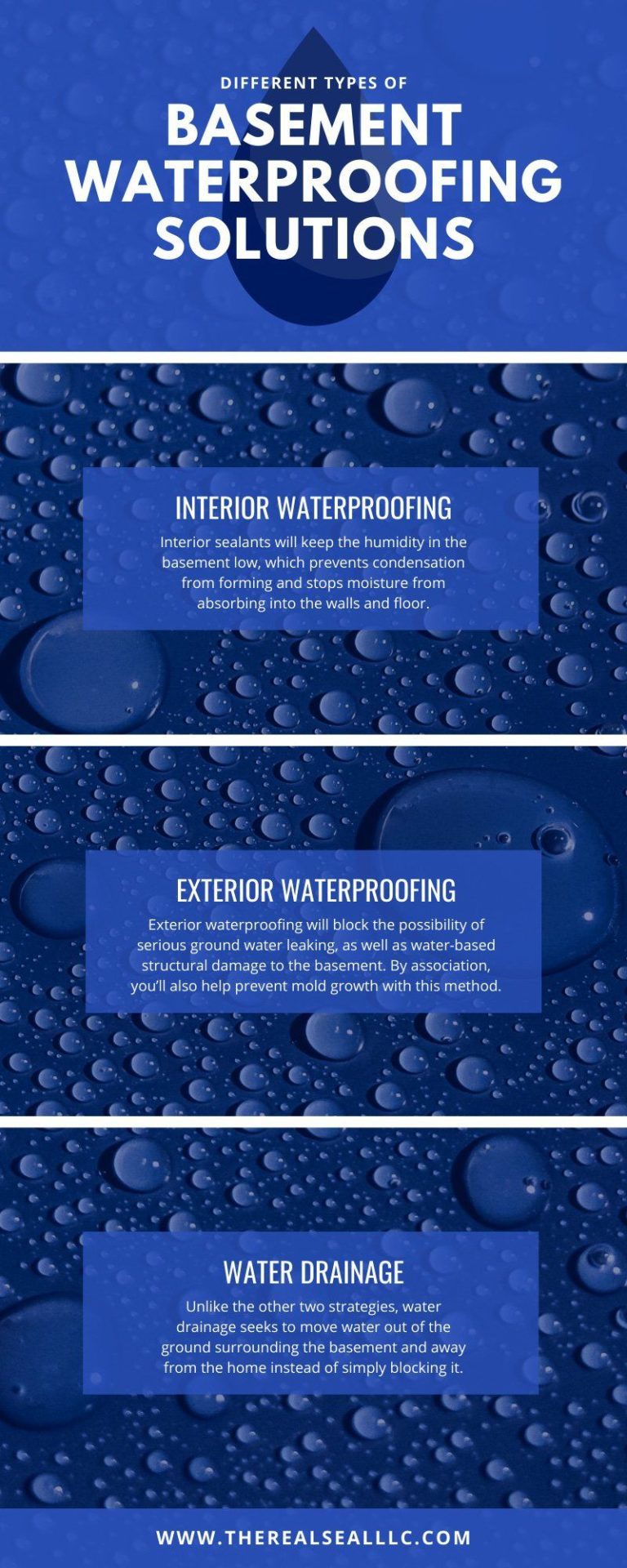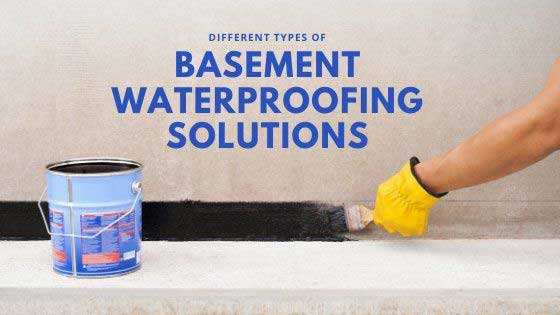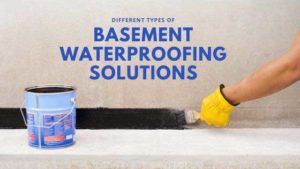Water in your basement poses a serious dilemma, as it can weaken the structure of your home, cause mold to grow, and make the space unviable. It also reflects an image of disrepair and dirtiness, and no one wants that. The question is not so much whether to stop water from entering your basement, but rather what approach you should use to prevent it. The severity of the damage, the level of disruption the solution poses, and the financial cost are all factors to consider as you weigh your options. Here are the three major types of basement waterproofing solutions most widely employed today.
Interior Waterproofing
The first solution is interior waterproofing. This entails applying sealants to any problem areas where moisture builds or where cracks allow water to seep in. Interior sealants will keep the humidity in the basement low, which prevents condensation from forming and stops moisture from absorbing into the walls and floor. In the winter, interior waterproofing can also help protect your basement against water that originates from melting snow and ice.
If your basement walls are bare, you can put concrete waterproof coatings directly onto your walls. You also have the choice to use a silicate sealer if you prefer. This sealant has increased durability because it soaks into the basement walls and chemically reacts with concrete to produce a waterproof barrier. If you have painted walls, you will need to use waterproofing paint instead, as the other sealants will not stick properly. Make sure you use a brush or roller to apply thick coats that can fill up cracks in all instances.
Interior waterproofing is the least intrusive and simplest option you have to treat leaks and moisture. Your wallet will not take much of a hit from it either when compared to the other techniques. You can easily access and implement the relevant interior waterproofing products, so you can choose to do it yourself or use the aid of a contractor.
It’s important know that interior waterproofing is a more temporary fix, and it will not always address the root of the water problems you have. Waterproofing is best suited for small cracks and other minor issues.
Exterior Waterproofing
In the instance that your home is still under construction, exterior waterproofing may be your best choice. With this method, you must excavate the soil around your home’s foundation several feet deep. Once completed, you can have the outside surfaces of your basement walls coated with waterproofing membranes. Of these, the most advantageous are polymers, which will last the lifetime of the home. Exterior waterproofing will block the possibility of serious ground water leaking, as well as water-based structural damage to the basement. By association, you’ll also help prevent mold growth with this method.
The downside to this type of waterproofing is that it’s more costly in both time and money. You should also only complete it in the initial building stages of your house. Digging up so much ground can cause problems, and it’s a risky process on a completed home, as it can lead to ground instability and can become counterproductive. Exterior waterproofing also presents the possibility of blocking up exterior drains. Exterior waterproofing offers more of a preemptive measure, and it’s not typically utilized in response to leaks for most cases.
If you deem exterior waterproofing to be the best course of action for your finished basement, make sure you can lawfully start your excavation. Extensive excavations usually require permits to complete them, and sometimes, only authorized contractors with special licenses may perform the work. To avoid wasting time and money, plan to dig in a dry time of year so that the ditch you create doesn’t fill up with water and delay progress.
Water Drainage
Unlike the other two strategies, water drainage seeks to move water out of the ground surrounding the basement and away from the home instead of simply blocking it. A group of porous plastic pipes is placed in the floor along the walls of the basement. They collect water from the concrete walls and the soil underneath into a holding receptacle called a sump pit in a system known as a drain tile. Plastic boards are also sometimes placed over the walls so that water leaking out of them falls straight to the periphery drainpipes. A sump pump then drives this collected water out of the basement and away from the home.
Water may also leave the pipes without the need for a pump if the foundation of the home is raised above the surrounding area. Such an arrangement relies on the pull of gravity to allow the water to move downhill away from the house.
The destination of the water can vary depending on each specific case. You may direct it to a municipal drain, a buried location where it can safely and slowly soak into the earth, or the open surface on level ground.
Since water drainage requires electricity for the pump and uses pipelines, you should take certain measures to ensure the arrangement continues to run smoothly in otherwise obstructive situations. You can connect a sump pump to isolated electric systems so that they remain functioning in the event of a power outage. In addition, incorporating a freeze guard as a part of the drainage path can provide an exit for water if the pipes freeze in colder months.
Water draining systems can usually be installed in a day or two, and the cost lies somewhere in between interior and exterior waterproofing. Installing a water drainage system disrupts the soil less than exterior water proofing, but it requires more work inside the basement than interior waterproofing. Their effectiveness and relatively straightforward installation in the hands of professionals may prove to be among the most effective solutions to carry out.
If the conditions of your basement are dire, and you require top of the line basement waterproofing in Chicago, IL, contact The Real Seal today. Our experts will attend to your home with their full focus to identify and confront all your basement leak problems at their source.








2 Responses
I don抰 even understand how I ended up right here, but I believed this publish was once good. I don’t understand who you might be but definitely you’re going to a well-known blogger should you aren’t already ;) Cheers!
The rabbit hole of Youtube and Google! Happy you came across us and enjoyed the blogs!